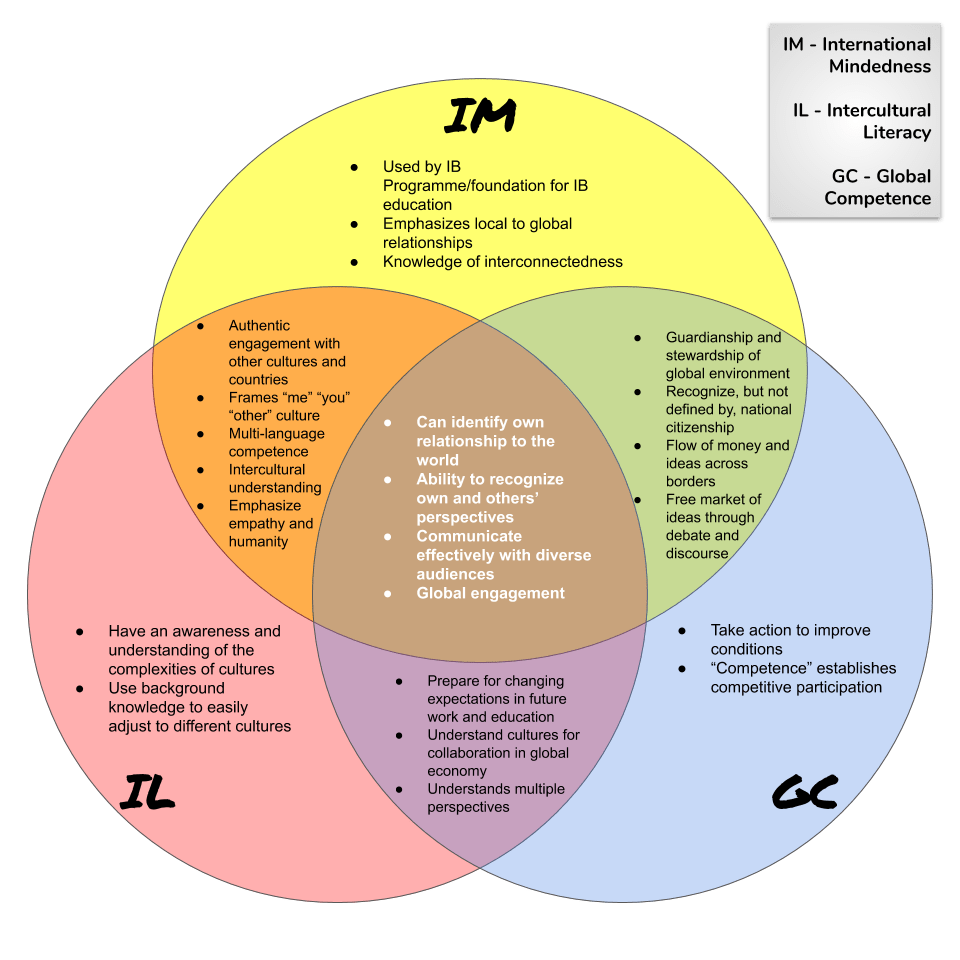International School Consultancy (ISC), a research entity that helps connect international schools and various investors and service providers, defines an international school as one that:
“delivers a curriculum to any combination of pre-school, primary or secondary students, wholly or partly in English outside an English-speaking country.” (Who we are, n.d.)
or
“is in a country where English is one of the official languages, it offers an English-medium curriculum other than the country’s national curriculum and the school is international in its orientation.” (Who we are, n.d.)
I feel this definition is too broad. Yes, it includes international schools in the traditional and modern sense, but it would also have to include any slapdash language school in Asia for example. I think the last part of the definition – “offers an English-medium curriculum other that the country’s national curriculum and the school is international in its orientations,” – is closer to the working definition understood worldwide. Even this outline shows signs of weakness as Ian Hill points out in What is an ‘international school’? Part One:
“Although the majority teach in English, it ignores those international schools operating wholly or partly in other languages of instruction such as IB World Schools in Spanish, French, Chinese, Russian, Turkish, Arabic, and Indonesian.” (2015, p. 64)
As ISC acknowledges, international schools were established originally as market-driven entities to educate the children of expatriate workers and diplomats assigned to posts around the world, outside their home country. (Informing international investment, 2019) (Hill, Part One, 2015) Mary Hayden and Jeff Thompson remind us that the notion of international schools and international education preceded even this definition. (1995) This separation of the international school and the idea of international education is an important one as many people speak of international education in a more defined way while discussing international schools with a wide and varying definition.
Ian Hill in What is an ‘international school’? Part Two discusses the difference between the international school and international education. The traditional sense of the international school as an institution set up for the education of mobile, expatriate children no longer feels like a useful category as the majority of international school students are now local students. (Informing international investment, 2019) That traditional definition fits very few schools now and Hill discusses at length the “purity” of international and national schools. Schools teaching international mindedness – rather than teaching local students for local and national needs and interests – is the more salient measure for categorizing this group of schools and thus being able to identify the unique needs of their students. Hill describes the school’s raison d’être as the key defining point that makes a school truly international, not where the school is located or who comprises the student population. (Hill, Part Two, 2016)
It is instructive here to discuss the philosophy of Kurt Hahn who extolled the virtues of experiential education amongst peers from other cultures. In a lifetime spanning the First and Second World Wars, Hahn realized the importance of young people spending quality time with those from other countries as a way to avoid repeating history’s mistakes of overblown national pride and jingoism. “Such sentiments do not thrive in a community where boys of different nations share the experiences of an enthralling school life.” (1936) He believed in the robust power of youth to temper adult extremists, to empathize with others, and to help us see the goodness in each other. (1943) He viewed youth as the key to a world beyond international wars for power and resources and saw the necessity of providing them an international education sourced from all the best practices, regardless of country of origin, that would develop warm, open, empathetic international mindedness. (1965)(1943) This educational philosophy still plays out in schools whose raison d’être is honed to developing students’ global citizenship and harnessing their energy, passion, and intellect for the good of the world, not simply the nation. This is not the same defining characteristic found in every “international” school.
Schools with a truly international focus, teaching international mindedness with the intention to develop global citizens, have needs quite different from national schools with the funding, infrastructure, curriculum, and governance provided by the state. Depending on the situation, an internationally-minded school may have any one, or all, of these support pillars coming from various sources in different countries. This forces an independence on the school, troubleshooting on its own. Not every organization will be equipped to do that successfully, so it is easy to understand the necessity of international support organizations such as the Alliance for International Education to help pick up the slack. In The Alliance for International Education: retrospective and prospective, Hayden describes the mission of this alliance as arising from the multitudinous support organizations, such as like-minded school associations, curriculum developers, professional development creators, accreditation agencies, and postgraduate links, all tasked with supporting and influencing international education in their own ways without unifying direction. (2016) Internationally-minded schools are only increasing in popularity, and as they do the need for this unifying framework will continue to grow. Unfortunately, there are a number of obstacles to achieving this unified direction across international borders, including funding, inclusion, language, logistics, and continuity. (Hayden, 2016)
While mostly originating in Europe, the greatest growth in international schools in the last 20 years has been in the Middle East and in Asia. Both of these regions have middle and high-income populations who can afford the educational option outside of national schools that international schools provide. This opportunity as local residents of the host country to attend international schools is seen as a vehicle for these students to attend elite, competitive universities in the West and to make international connections that will benefit their career prospects in the future. (Homden, 2019) The appeal of western universities is not likely to wane anytime soon.
Even in the face of the recent COVID-19 pandemic and the economic hit to the world economy, Asia is still likely to be the area of widest growth in international school student enrollment looking ahead. Dr. Stephen Whitehead writes that China, South Korea, Taiwan, Japan, Malaysia, Singapore, and others are already experiencing an international school boom and they are also the countries best able to sustain the economic impact of COVID-19 based on their national infrastructure, governance, value placed on education, healthcare, and other factors. (2020)
The popularity of “international” schools, especially internationally-minded schools in the mold described by Hahn, Hayden, and Hill, will continue to grow for some decades as will the number of students they serve, teachers and staff they employ, and communities in which they operate. Though I don’t want to focus on economics, tuition fees, profits/non-profits, funding, etc., the amount of money involved cannot be ignored either. It would be perilous for policy makers, universities, corporations, and other influencers to neglect this vast education system with so much to offer the global community, merely because it falls outside existing national borders and older, traditional education frameworks.
References
Hahn, K. (1936, March 24). Education and Peace: The Foundations of Modern Society. The Inverness Courier. Retrieved from http://www.kurthahn.org/wp-content/uploads/2016/04/ed_peace.pdf
Hahn, K. (1965, May 9). Harrogate Address on Outward Bound. Address presented at Conference at Harrogate, England. Retrieved from http://www.kurthahn.org/wp-content/uploads/2016/04/gate.pdf
Hahn, K. (1943). Two Sermons. Address presented in Gordunstoun School, Elgin. Retrieved from http://www.kurthahn.org/wp-content/uploads/2017/02/2017-sermons.pdf
Hayden, M., & Thompson, J. (1995). International Schools and International Education: A relationship reviewed. Oxford Review of Education, 21(3), 327-345. doi:10.1080/0305498950210306
Hayden, M. (2016, April). The Alliance for International Education: Retrospective and prospective. International Schools Journal, 35(2), 86-93.
Hill, I. (2015, November). What is an ‘international school’? Part One. International Schools Journal, 35(1), 60-70.
Hill, I. (2016, April). What is an International School? Part Two. International Schools Journal, 35(2), 9-21.
Homden, A. (2019, June). Why are there so many international schools, and what are the implications? International Teacher Magazine. Retrieved from https://searchality.com/discover/schools/why-are-there-so-many-international-schools/
Informing international investment. (2019, August 7). ISC Research. Retrieved from https://www.iscresearch.com/news-and-events/isc-news/isc-news-details/~post/informing-international-investment-20190807
Whitehead, S. (2020, May). The Future of International Education. Educational Digest International, COVID-19 Special Edition II. Retrieved from https://eddi.substack.com/p/eddi-covid-19-special-edition-ii
Who we are. (n.d.). ISC Research. Retrieved from https://www.iscresearch.com/about-us/who-we-are



